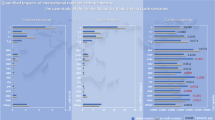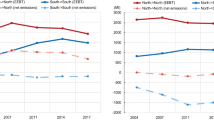Abstract
This paper quantifies the carbon emissions embodied in the bilateral trade between India from the non-Annex-I country list under the Kyoto Protocol (1997) with two of its biggest trade partners from the Annex-II country list, the USA and the UK, by applying the input–output modelling during the years of 2011 to 2014, to evaluate and analyse the conjecture around the carbon leakage. After the calculation of the embodied carbon in these bilateral exports and imports, the study further inspects the roles of important drivers those are influencing the calculated emission imbalances in trade. This study addresses a high emission-intensive energy consumption pattern of India relative to both the USA and the UK which is confirming the possibility of carbon leakage from Indian commodity production sectors and inducing a huge contribution from these bilateral trades into the global emissions. Finally, this study provides evidence from a spatial decomposition analysis that the differences among the emission-intensity of output between India and its major developed country trade partners create the maximum impact on the implied emission imbalances in the bilateral trades. With the anticipation of increased India–USA and the India–UK bilateral trade, this study proposes suggestion to reduce India’s emission intensity of output through fuel switching to the less emission-intensive energy options and relieve the pressure on the global environment.

Note: The volumes of export are measured in US$ Millions for the year 2016.

Note: Carbon emissions measured in Kilo-Tonne unit.

Note: Emission surplus is measure in Kilo-Tonnes, trade surplus is measure in million dollars.

Source: United Nations Energy Statistics Yearbook 2015

Note: Emissions measured in Mt.

Note: Emissions measured in Mt.

Note: Emissions measured in Mt.

Source: Author’s Own Elaboration
Similar content being viewed by others
Notes
The targets of the Kyoto Protocol during its first commitment period for 2008 to 2012 covered emissions of six main GHGs, namely carbon dioxide, methane, nitrous oxide, hydro-fluorocarbons, per-fluorocarbons and sulphur hexafluoride.
These assigned amounts are calculated based on a Party’s quantified emission limits and reduction commitments over a commitment period recorded in Annex-B of the Protocol based on their corresponding emission levels in the year 1990 (UNFCCC).
Besides all the mitigation initiatives, one important economic argument behind this break in the pattern of US emission trend may be due to the subprime mortgage financial crisis which slowed down the US economy since 2007 and caused a fall in aggregate demand.
“Appendix B.1”, “B.2” and “B.3” elaborates the calculation of weights associated with each energy items in the broad energy groups for India, the USA and the UK, respectively. In “Appendix B.4.1”, the elaboration of carbon emission factors of electricity for India, the USA and the UK is shown. “Appendix B.4.2” shows the proportions of different sources as contributors in the electricity generation for the three countries. “Appendix B.4.3” elaborates on the calculation of the emission factor of heat for the USA and the UK.
References
Aichele, R., & Felbermyr, G. (2015). Kyoto and carbon leakage: An empirical analysis of the carbon content of bilateral trade. The Review of Economics and Statistics, 97(1), 104–115.
Ang, B. W. (2004). Decomposition analysis for policymaking in energy: Which is the preferred method? Energy Policy, 32(9), 1131–1139.
Ang, B. W., Huan, H. C., & Mu, A. R. (2009). Properties and linkages of some index decomposition analysis methods. Energy Policy, 37(11), 4624–4632.
Ang, B. W., Xu, X. Y., & Su, B. (2015). Multi-country comparisons of energy performance: The Index decomposition analysis approach. Energy Economics, 47, 68–76.
Antimiani, A., Costantini, V., Martini, C., Salvatici, L., & Tommasino, L. C. (2013). Assessing alternative solutions to carbon leakage. Energy Economics, 36, 299–311.
Banerjee, S. (2019). Addressing the drivers of carbon emissions embodied in Indian exports: An index decomposition analysis. Foreign Trade Review, 54(4), 300–333.
Banga, R. (2016). BREXIT: Opportunities for India. Emerging Issues Briefing Paper (7), the Commonwealth Secretariat. London, United Kingdom, http://thecommonwealth.org/sites/default/files/inline/TCBP_Paper%2001_Brexit%20Opportunities%20for%20India.pdf
Bohringer, C., Bye, B., Faehn, T., & Rosendahl, K. E. (2017). Targeted carbon tariffs: Export response, leakage and welfare. Resource and Energy Economics, 50, 51–73.
Branger, F., & Quirion, P. (2014). Would border carbon adjustments prevent carbon leakage and competitiveness losses? Insights from a meta-analysis of recent economic studies. Ecological Economics, 99, 29–39.
Chang, N. (2013). Sharing responsibilities for carbon dioxide emissions: A perspective on border tax adjustments. Energy Policy, 59, 850–856.
Chen, Y. (2009). Does a regional greenhouse gas policy makes sense? A case study of carbon leakage and emission spillover. Energy Economics, 31, 667–675.
Chen, L., & Yang, Z. (2015). A spatio-temporal decomposition analysis of energy-related CO2 emission growth in China. Journal of Cleaner Production, 103, 49–60.
Du, H., Guo, J., Mao, G., Smith, A. M., Wang, X., & Wang, Y. (2011). CO2 emissions embodied in China-US trade: Input-output analysis based on the emergy/dollar ratio. Energy Policy., 39, 5980–5987.
Guo, J., Zou, L. L., & Wei, Y. M. (2010). Impact of inter-sectoral trade on national and global CO2 emissions: An empirical analysis of China and US. Energy Policy, 38, 1389–1397.
Jayanthakumaran, K., & Liu, Y. (2016). Bilateral CO2 emissions in embodied in Australia China trade. Energy Policy, 92, 205–213.
Ji, X., Liu, Y., Han, M., & Meng, J. (2020). The mutual benefits from Sino-Africa trade: Evidence on emission transfer along the global supply chain. Journal of Environmental Management. https://doi.org/10.1016/j.jenvman.2020.110332.
Kallbekken, S., Flottorp, L. S., & Rive, N. (2007). CDM baseline approaches and carbon leakage. Energy Policy, 35, 4154–4163.
Kuik, O. (2002). The Effect of Trade Liberalization on Carbon Leakage with Kyoto Protocol: Experiments with GTAP-E. Paper prepared for the 4th Annual Conference on Global Economic Analysis. West Lafayette, Purdue University. https://pdfs.semanticscholar.org/dbf5/bd71ed0f79c77e66c11d27dc417bcc152fdf.pdf
Li, Y., & Hewitt, C. N. (2008). The effect of trade between China and the UK on national and global carbon dioxide emissions. Energy Policy., 36, 1907–1914.
Li, A., & Zhang, A. (2012). Will carbon motivated border tax adjustment function as a threat? Energy Policy, 47, 81–90.
Liu, X., Ishikawa, M., Wang, C., Dong, Y., & Liu, W. (2010). Analysis of CO2 emissions embodied in Japan-China trade. Energy Policy, 38, 1510–1518.
Liu, Z., Mao, X., & Song, P. (2016). GHGs and Air pollutants embodied in China’s international trade: Temporal and spatial index decomposition analysis. PLoS ONE, 12(4), e0176089. https://doi.org/10.1371/journal.pone.0176089.
Liu, Z., Mao, X., & Song, P. (2017). GHGs and Air pollutants embodied in China’s international trade: Temporal and spatial index decomposition analysis. PLoS ONE, 12(4), e0176089. https://doi.org/10.1371/journal.pone.0176089.
Long, R., Li, J., Chen, H., Zhang, L., & Li, Q. (2018). Embodied carbon dioxide flow in International trade: A comparative analysis based on China and Japan. Journal of Environmental Management, 209, 371–381.
Lopez, L. A., Arce, G., & Zafrilla, J. E. (2013). Parcelling virtual carbon in the pollution haven hypothesis. Energy Economics, 39, 177–186.
Machado, G., Schaeffer, R., & Worrell, E. (2001). Energy and carbon emission embodied in international trade of Brazil: An input-output approach. Ecological Economics, 39, 409–424.
Mahony, T. O. (2013). Decomposition of Ireland’s carbon emission from 1990 to 2010: An extended Kaya identity. Energy Policy, 59, 573–581.
Moutinho, V., Moreira, A. C., & Silva, P. M. (2015). The driving forces of change in energy-related CO2 emissions in Eastern, Western, Northern and Southern Europe: The LMDI approach to decomposition analysis. Renewable and Sustainable Energy Reviews, 50, 1485–1499.
Peters, G. P. (2008). From production-based to consumption-based national emission inventories. Ecological Economics, 65, 13–23.
Peters, G. P., & Hertwich, E. G. (2008). CO2 embodied in international trade with implications for global climate policy. Environmental Science Technology, 42(2), 1401–1407.
Peters, G. P., Minx, J. C., Weber, C. L., & Edenhofer, O. (2011). Growth in emission transfers via international trade from 1990 to 2008. Proceedings of the National Academy of Sciences of United States of America, 108, 8903–8908. https://doi.org/10.1073/pnas.1006388108.
Rocchi, P., Serrano, M., Roca, J., & Arto, I. (2018). Border carbon adjustment based on avoided emissions: Addressing the challenge of its design. Ecological Economics, 145, 126–136.
Shahiduzzaman, M. D., Layton, A., & Alam, K. (2015). Decomposition of energy-related CO2 emissions in Australia: Challenges and policy implications. Economic Analysis and Policy, 45, 100–111.
Shui, B., & Harriss, R. C. (2006). The role of CO2 embodiement in US-China trade. Energy Policy., 34(18), 4063–4068.
Su, B., Huang, H. C., Ang, B. W., & Zhou, P. (2010). Input-output analysis of CO2 emissions embodied in trade: The effects of sector aggregation. Energy Economics, 32(1), 166–175.
Tan, H., Sun, A., & Lau, H. (2013). CO2 embodiment in China-Australia trade: The drivers and implications. Energy Policy., 61, 1212–1220.
Weidmann, T., Lenzen, M., Turner, K., & Barett, J. (2007). Examining the global environmental impact of regional consumption activities—Part 2: Review of input–output models for the assessment of environmental impacts embodied in trade. Ecological Economics, 61(1), 15–26.
Wu, R., Geng, Y., Dong, H., Fujita, T., & Tian, X. (2016). Changes of CO2 emissions embodied in China-Japan trade: drivers and implications. Journal of Cleaner Production, 112, 4151–4158.
Wyckoff, A. W., & Roop, J. M. (1994). The embodiment of carbon in imports of manufacturing products: Implications for international agreements on greenhouse gas emissions. Energy Policy, 22(3), 187–194.
Yu, Y., & Chen, F. (2017). Research on carbon emission embodied in trade between China and South Korea. Atmospheric Pollution Research, 8, 56–63.
Zhang, W., Li, K., Zhou, D., Zhang, W., & Gao, H. (2016). Decomposition of intensity of energy-related CO2 emission in Chinese provinces using LMDI method. Energy Policy, 92, 369–381.
Acknowledgements
This research did not receive any specific grant from funding agencies in the public, commercial or not-for-profit sectors.
Author information
Authors and Affiliations
Corresponding author
Additional information
Publisher's Note
Springer Nature remains neutral with regard to jurisdictional claims in published maps and institutional affiliations.
Appendices
Appendix A
See Table 8.
Appendix B
2.1 Appendix B.1
See Table 9.
2.2 Appendix B.2
See Table 10.
2.3 Appendix B.3
See Table 11.
2.3.1 Appendix B.4
2.3.1.1 Appendix B.4.1
See Table 12.
2.3.1.2 Appendix B.4.2
See Table 13.
2.3.1.3 Appendix B.4.3
See Table 14.
Rights and permissions
About this article
Cite this article
Banerjee, S. Addressing the carbon emissions embodied in India’s bilateral trade with two eminent Annex-II parties: with input–output and spatial decomposition analysis. Environ Dev Sustain 23, 5430–5464 (2021). https://doi.org/10.1007/s10668-020-00824-9
Received:
Accepted:
Published:
Issue Date:
DOI: https://doi.org/10.1007/s10668-020-00824-9




